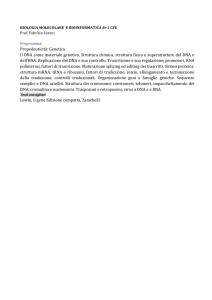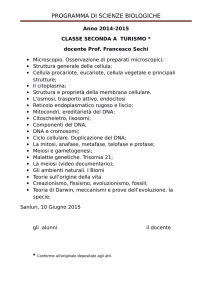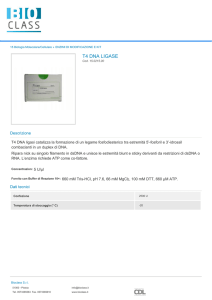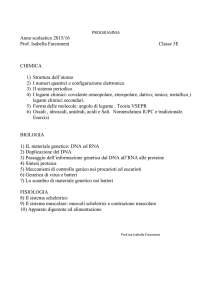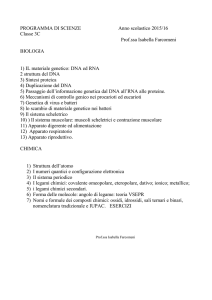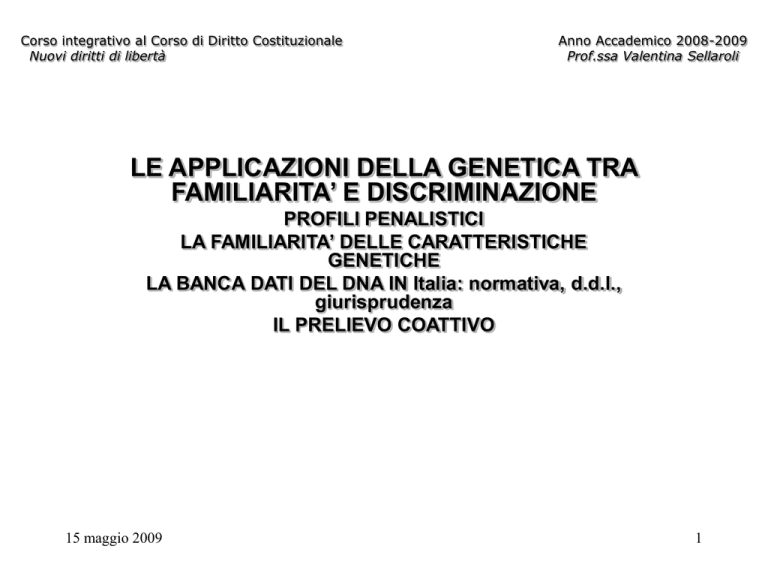
Corso integrativo al Corso di Diritto Costituzionale
Nuovi diritti di libertà
Anno Accademico 2008-2009
Prof.ssa Valentina Sellaroli
LE APPLICAZIONI DELLA GENETICA TRA
FAMILIARITA’ E DISCRIMINAZIONE
PROFILI PENALISTICI
LA FAMILIARITA’ DELLE CARATTERISTICHE
GENETICHE
LA BANCA DATI DEL DNA IN Italia: normativa, d.d.l.,
giurisprudenza
IL PRELIEVO COATTIVO
15 maggio 2009
1
DNA (CODICE O PROFILO GENETICO)
• Strumento di analisi ed oggetto di
studio a fini terapeutici o di ricerca
• Strumento di identificazione a fini
forensi per il suo potere informativo e
per le sue caratteristiche di “unicità ed
individualità”…
…ma è davvero così?
15 maggio 2009
2
COME SI ARRIVA ALLA
IDENTIFICAZIONE TRAMITE IL DNA?
• Raccolta di campioni biologici
• Estrazione del dna dai materiali e dai tessuti che lo
contengono
• Eventuale amplificazione del materiale genetico trovato
• Studio delle sequenze genomiche utilizzate come
marcatori
• Lettura e valutazione dei risultati alla luce di conoscenze
statistico-scientifiche acquisite
15 maggio 2009
3
L’ESAME DEL DNA può condurre
• Alla conoscenza del genotipo di un essere umano, cioè
del suo “programma genetico” che in parte è ciò che un
individuo appare all’esterno (fenotipo)
• Alla valutazione della probabilità con cui un certo tessuto
o un certo materiale biologico è da attribuire ad un
determinato individuo ed a lui solo (capacità identificativa
del DNA)
15 maggio 2009
4
corrisponde grosso modo alla differenza tra
• Sequenze genomiche cd. codificanti
e
• Sequenze genomiche cd. non codificanti
15 maggio 2009
5
RAGIONI DELLA SCELTA DELLE SEQUENZE
NON CODIFICANTI COME MARCATORI AD
USO FORENSE
• Necessità di evitare discriminazioni anche solo potenziali,
ad esempio su base razziale
• Difficoltà anche sociali a condurre studi genetici non su
popolazioni ma su blocchi di individui caratterizzati non
tanto da provenienza etnica quanto da determinate
caratteristiche genetiche che si esprimono in un certo
fenotipo
• Non pacificità e quantificabilità di criteri statistici
identificativi basati su questi parametri di classificazione
15 maggio 2009
6
IL DNA COME IMPRONTA DIGITALE
• DNA fingerprinting: l’impronta digitale genetica è unica ed
univoca?
2 ordini di domande:
• Il profilo genetico identifica con certezza l’individuo al
quale appartiene? Con che margine di errore?
• Il profilo genetico identifica SOLO l’individuo al quale
appartiene?
NO…
15 maggio 2009
7
IL “GRUPPO BIOLOGICO”
• I dati genetici sono ereditabili nell’ambito della famiglia
biologica
• I dati genetici sono anche condivisi nell’ambito di persone
legate da vincolo biologico
Che cosa comporta ciò?…
15 maggio 2009
8
…sul piano investigativo
• Il dato genetico non serve più solo a comparare due profili
genetici (quello trovato sulla scena del crimine e quello del
o dei potenziali sospettati) ma anche…
• …a cercare un sospettato potenziale in un ambito
potenzialmente illimitato
Come?
• Attraverso ricerche, per così dire, indirette , potremmo dire
de relato
15 maggio 2009
9
Un caso concreto: Dobbiaco
Aprile 2002: una anziana donna viene trovata
violentata ed uccisa nel paesino di Dobbiaco.
Abbondanti tracce biologiche sulla vittima.
I principali sospettati vengono esclusi dalle
primissime indagini.
Gli investigatori sono convinti che l’assassino sia
“uno del posto” e notano una notevole
omogeneità tra i profili genetici degli abitanti del
luogo…
Non ci sono altri sospettati
15 maggio 2009
10
SCREENING DI MASSA
(intelligence led-screen)
• Quasi tutti gli abitanti maschi del paesino “donano” il loro
DNA per essere esclusi dal novero dei sospettati
• Viene finalmente trovata una corrispondenza parziale
molto interessante tra uno dei “donatori” ed il profilo
genetico dell’assassino: i due profili corrispondono al 50%
• Il cerchio si chiude. La low-stringency search ha ottenuto il
suo scopo: l’anziano signore è il padre dell’assassino
15 maggio 2009
11
DATO GENETICO CONDIVISO
• Nuovo concetto di identità e di identificazione: non più
solo l’identità assoluta e diretta ma una identità relativa ed
indiretta che si estende a tutti coloro che condividono
parzialmente lo stesso patrimonio genetico
…
15 maggio 2009
12
DATO GENETICO CONDIVISO
• Che conseguenze ha ciò sul piano del valore e della
disciplina dell’analisi del DNA sul piano investigativo e
forense?
15 maggio 2009
13
La legge
• Vuoto legislativo anche sulla questione dell’acquisizione
del campione biologico da cui estrarre il profilo genetico:
art. 224 co. 2 c.p.p. come modificato dalla sentenza Corte
Cost. n. 238/96:
non sono più possibili da parte del giudice “altri
provvedimenti necessari per la esecuzione delle
operazioni peritali”
15 maggio 2009
14
I principi costituzionali
• Articolo 13 Cost.:
Diritti di libertà personale non solo e non tanto nel senso di
inviolabilità fisica, ma anche nel senso di inviolabilità
personale in senso lato:
riservatezza informazionale
15 maggio 2009
15
ne consegue
Un nuovo doppio livello di privacy:
uno diretto ed individuale
un altro personale ma indiretto ed allargato alla cerchia dei
congiunti di ciascun individuo
15 maggio 2009
16
il consenso richiesto agli abitanti di Dobbiaco
(de iure condendo)
• È stato un “consenso informato”?
• Doveva esserlo?
• Che ne è stato della tutela della riservatezza dei congiunti
e del riconoscimento del sentimento di pietas familiare che
pure trova spazio nel nostro ordinamento processuale
(art. 199 c.p.p.)?
15 maggio 2009
17
il consenso richiesto agli abitanti di Dobbiaco
(de iure condito)
• Che cosa sarebbe successo se l’assassino non avesse
confessato?
15 maggio 2009
18
Banche dati genetiche e familial searching
• Caso Harman (UK, 2003)
• Caso Herisch (Germania, 2005)
“…ma la polizia federale non è una organizzazione criminale e
dunque non ci sono da temere abusi…”
• Caso Harper vs UK (ECHR, 2008)
15 maggio 2009
19
Banche dati genetiche e familial searching
Caso Harman (UK, 2003)
Surrey (UK)
Mr. Craig Harman was convicted of manslaughter on the basis of “familial DNA
searching” which linked him to the crime scene via a close relative’s DNA
profile. Harman threw a brick from a bridge over a motorway which crashed
through the windscreen of a lorry. The brick hit driver’s chest and killed him.
Police obtained a DNA profile of the assailant from blood on the brick, but
could not match it to anything on the UK’s national Databank because
Harman had no criminal convictions. The Police used familial searching to
uncover a close relative of Harman’s, who had a criminal conviction and was
on the DNA bank. The relative’s profile matched the DNA on the brick by 16
out of 20 locations. This lead the Police to Harman, whose DNA gave a
perfect match.
He confessed the crime.
15 maggio 2009
20
Banche dati genetiche e familial searching
Caso Herisch (Germania, 2005)
Rudolph Mooshammer, a famous aute couture tailor and
eccentric person, was murdered after a tragic altercation for
an unpaid homosexual affair
Policemen found some murderer’s hair on the crime scene and
extracted a clear DNA profile of the crime’s author
In 36 hours Police reached the murderer, Mr. H. Herish and a
perfect match with his DNA profile was found
The problem:
German police found Mr. Herish searching in the national
DNA database but his profile should not have been stored
into the database
He gave his bio-sample years before in order to be excluded
from another criminal investigation and, according to the
German
law, he should have been excluded after that. 21
15 maggio
2009
Le questioni in gioco:
• Ciascun profilo genetico inserito in banca dati reca
informazioni relativamente non ad un solo individuo ma a
tutto il suo “gruppo biologico”
• È possibile identificare così un numero di persone ben
maggiore dei profili inseriti in banca dati
• Quale valore ed estensione ha il consenso di coloro che
volontariamente lasciano inserire il proprio profilo genetico
in banca dati?
15 maggio 2009
22
una considerazione
La legittimità di speculative searches e della possibilità di
sfruttare i vantaggi del family searching è messa in dubbio
anche dove risorse investigative come la comparazione
dei profili genetici e delle banche dati genetiche sono da
tempo ammesse e regolamentate
15 maggio 2009
23
BANCHE DATI DNA e diritti individuali
UNA BANCA DATI DEL DNA A FINI
FORENSI è UN DATABASE IN CUI
PROFILI DI DNA, PROVENIENTI DA
FONTI DIVERSE, SONO
CONSERVATI A FINI DI
INVESTIGAZIONI FUTURE
15 maggio 2009
24
BANCHE DATI DNA e diritti individuali
GLI SCOPI:
Cercare corrispondenze tra profili genetici
ottenuti dalla vittima o provenienti dalla
scena del crimine e profili genetici
contenuti nel database
15 maggio 2009
25
BANCHE DATI DNA e diritti individuali
• Aprile, 1995: The Forensic Science Service istituisce il
primo database del DNA a fini forensi per l’Inghilterra ed
il Galles (NDNAD, National DNA Database)
- Attualmente il NDNAD contiene quasi 4 milioni di profili
genetici estratti da campioni biologici prelevati da sospettati o
da persone indagate o incriminate (The NDNAD Annual Report,
March, 2005);
- Cresce al tasso di 30000 profili genetici al mese;
- in un mese tipo, vengono trovate corrispondenze per circa 15
omicidi, 31 stupri, 330 furti d’auto (The NDNAD Annual Report,
July, 2003)
15 maggio 2009
26
BANCHE DATI DNA e diritti individuali
• Ottobre, 1998: l’FBI apre il CODIS (Combined
Dna Index System), un Database federale che
riunisce circa 50 database nazionali
Some facts:
- Il CODIS contiene 170.000 profili genetici utili a fini
forensi e 4.782 profili genetici di autori di reati (FBI
Website);
- Il CODIS è ora il più grande database genetico a fini
investigativi del mondo;
- Fino ad ora il CODIS è stato impiegato in circa
77.700 indagini investigative
15 maggio 2009
27
BANCHE DATI DNA e diritti individuali
• Molti altri paesi europei hanno già una banca dati
del DNA:
1997, Olanda e Austria;
1998, Germania
1999, Finlandia e Norvegia
2000, Danimarca, Svezia e Svizzera
.. L’Italia sta ancora aspettando
15 maggio 2009
28
Banche dati genetiche e familial
searching
Caso S e Marper vs UK (ECHR, 2008)
The first applicant, Mr S., was arrested on 19 January 2001 at the age of
eleven and charged with attempted robbery. His fingerprints and DNA
samples1 were taken. He was acquitted on 14 June 2001.
The second applicant, Mr Michael Marper, was arrested on 13 March 2001 and
charged with harassment of his partner. His fingerprints and DNA samples
were taken. Before a pre-trial review took place, he and his partner had
become reconciled, and the charge was not pressed. On 11 June 2001, the
Crown Prosecution Service served a notice of discontinuance on the
applicant's solicitors, and on 14 June the case was formally discontinued.
Both applicants asked for their fingerprints and DNA samples to be destroyed,
but in both cases the police refused. The applicants applied for judicial
review of the police decisions not to destroy the fingerprints and samples.
On 22 March 2002 the Administrative Court (Rose LJ and Leveson J)
rejected the application.
15 maggio 2009
29
Caso S e Marper vs UK (ECHR, 2008)
• The issue to be considered by the Court in this case was whether the
retention of the fingerprint and DNA data of the applicants, as persons who
had been suspected, but not convicted, of certain criminal offences, was
necessary in a democratic society. The Court noted that England, Wales and
Northern Ireland appeared to be the only jurisdictions within the Council of
Europe to allow the indefinite retention of fingerprint and DNA material of
any person of any age suspected of any recordable offence.
• It observed that the protection afforded by Article 8 of the Convention would
be unacceptably weakened if the use of modern scientific techniques in the
criminal-justice system were allowed at any cost and without carefully
balancing the potential benefits of the extensive use of such techniques
against important private-life interests.
• In conclusion, the Court found that the blanket and indiscriminate nature of
the powers of retention of the fingerprints, cellular samples and DNA profiles
of persons suspected but not convicted of offences, as applied in the case of
the present applicants, failed to strike a fair balance between the competing
public and private interests, and that the respondent State had overstepped
any acceptable margin of appreciation in this regard. Accordingly, the
retention in question constituted a disproportionate interference with the
applicants’ right to respect for private life and could not be regarded as
necessary
in a democratic society.
15 maggio 2009
30
BANCHE DATI DNA e diritti individuali
..i pro
• Le banche dati del DNA possono aiutare gli investigatori in casi
che, senza questo strumento investigativo, rimarrebbero
probabilmente insoluti
• Le banche dati del DNA possono fornire soluzione a casi
irrisolti
• Le banche dati del DNA possono aiutare a scagionare persone
innocenti
15 maggio 2009
31
BANCHE DATI DNA e diritti individuali
….e i contro
• I dati genetici possono rivelare informazioni sensibili sugli
individui, come stato di salute, razza, genere e altre caratteristiche
ereditarie
• Dato che i dati genetici sono condivisi all’interno del gruppo
biologico, possono rivelare informazioni sensibili anche su altre
persone
• Effettuare ricerche all’interno di una banca dati significa che di fatto
tutti gli individui i cui profili genetici sono inseriti in banca dati
sono periodicamente oggetto di comparazione con profili genetici
provenienti da scene del crimine
15 maggio 2009
32
BANCHE DATI DNA e diritti individuali
Occorre trovare un bilanciamento tra ordine
pubblico e protezione dei diritti individuali
In tal senso i punti cruciali sono:
15 maggio 2009
33
BANCHE DATI DNA e diritti individuali
1. Quali profili vengono inseriti in banca dati?
Chiunque sia sospettato o indagato per un reato (UK,
Austria, Germania);
Solo le persone condannate (USA, Olanda, Svezia)
15 maggio 2009
34
BANCHE DATI DNA e diritti individuali
2. Per quali reati si viene inseriti in
banca dati?
Qualsiasi reato, anche minore (UK)
Solo alcuni tipi di reati (reati di tipo
sessuale, fatti di sangue, reati di droga)
(Austria, Germania, USA);
Reati puniti con pene superiori ad un certo
limite minimo (Olanda, Danimarca)
15 maggio 2009
35
BANCHE DATI DNA e diritti individuali
3. Per quanto tempo i profili
devono/possono rimanere in banca dati?
Devono essere rimossi:
Solo gli indagati che sono stati assolti (UK, Austria,
USA);
Tutti in ogni caso dopo un certo numero di anni
(Olanda, Svezia)
Su richiesta (Switzerland)
D’ufficio (nella maggior parte degli altri paesi)
15 maggio 2009
36
BANCHE DATI DNA e diritti individuali
4. Anonimato dei profili genetici e
identificazione
Separazione tra gli archivi dei profili genetici e gli
archivi anagrafici (la maggior parte dei paesi)
Conservazione congiunta dei profili genetici e dei dati
personali (Germania)
15 maggio 2009
37
BANCHE DATI DNA e diritti individuali
5. Conservazione dei campioni biologici
Distruzione immediata dei campioni biologici
Conservazione dei campioni per eventuali usi futuri
15 maggio 2009
38
D.D.L. 2042
adesione al trattato di PRUM
• Creazione di una banca dati del DNA ove saranno inseriti i
profili genetici di soggetti coinvolti in fatti di reato, profili
provenienti da scene del crimine, profili relativi a persone
scomparse e loro consanguinei
• Individuazione dei profili da inserire:
– Soggetti arrestati, fermati o in misura cautelare
– Soggetti condannati con sentenza definitiva
– Soggetti in misura di sicurezza
• Limitazione dei soggetti legittimati all’accesso e degli scopi
dello stesso
• Limite temporale massimo alla conservazione di profili (40 anni)
e campioni biologici (20 anni)
• Prelievo coattivo su indagati e anche su persone non iscritte nel
registro degli indagati
15 maggio 2009
39
PRUM CONVENTION, 27 May 2005
between the Kingdom of Belgium, the Federal Republic
of Germany, the Kingdom of Spain, the French
Republic, the Grand Duchy of Luxembourg, the
Kingdom of the Netherlands and the Republic of
Austria on the stepping up of cross-border
cooperation, particularly in combating terrorism,
cross-border crime and illegal migration
15 maggio 2009
40
The PRUM Convention
Chapter 2
DNA profiles and fingerprinting and other data
Article 2
Establishment of national DNA analysis files
1. The Contracting Parties hereby undertake to open and keep national DNA analysis
files for the investigation of criminal offences. Processing of data kept in those files,
under this Convention, shall be carried out subject to its other provisions, in
compliance with the national law applicable to the processing.
2. For the purpose of implementing Convention, the Contracting Parties shall ensure the
availability of reference data from their national DNA analysis files as referred to in the
first sentence of paragraph 1. Reference data shall only include DNA profiles*
established from the non-coding part of DNA and a reference. Reference data must
not contain any data from which the data subject can be directly identified. Reference
data not traceable to any individual (untraceables) must be recognisable as such.
3. When depositing instruments of ratification, acceptance, approval or accession, each
Contracting Party shall specify the national DNA analysis files to which Articles 2 to 6
are applicable and the conditions for automated searching as referred to in Article
3(1).
* For the Federal Republic of Germany, DNA profiles as referred to in this Convention
shall mean DNA-Identifizierungsmuster (DNA identification patterns).
15 maggio 2009
41
The PRUM Convention
Article 3
Automated searching of DNA profiles
1. For the investigation of criminal offences, the Contracting Parties shall allow other
Contracting Parties' national contact points, as referred to in Article 6, access to the reference
data in their DNA analysis files, with the power to conduct automated searches by comparing
DNA profiles. Search powers may be exercised only in individual cases and in compliance
with the searching Contracting Party's national law.
2. Should an automated search show that a DNA profile supplied matches a DNA profile entered
in the Contracting Party's file searched, the searching contact point shall receive automated
notification of the hit and the reference. If no match can be found, automated notification of
this shall be given.
Article 4
Automated comparison of DNA profiles
1. For the investigation of criminal offences, the Contracting Parties shall, by mutual consent,
via their national contact points, compare the DNA profiles of their untraceables with all
DNA profiles from other national DNA analysis files' reference data. Profiles shall be
supplied and compared in automated form. DNA profiles of untraceables shall be supplied
for comparison only where provided for under the requesting Contracting Party's national law.
2. Should a Contracting Party, in the comparison referred to in paragraph 1, find that any
DNA profiles supplied match those in its DNA analysis file, it shall without delay supply the
other Contracting Party's national contact point with the reference data with which a match
has been found.
15 maggio 2009
42
Alcune raccomandazioni (Gene Watch Report, UK, 2005)
• Distruzione dei campioni di DNA (tranne quelli raccolti sulla scena del
crimine) una volta che l’indagine sia completata;
• Istituzione di autorità indipendenti per vigilare sulle applicazioni della
banca dati;
• Creazione di un “innocence Project” per correggere eventuali errori
giudiziari;
• Rimozione dalla banca dati dei profili degli individui prosciolti dalle
accuse
• Previsione di un termine massimo di conservazione
• Impossibilità di prelievo coatto di campioni biologici da individui non
indagati (es. persone offese)
15 maggio 2009
43
…un nuovo concetto di individuo?
The John Doe DNA warrant does not list a name. It describes only the suspect’s genetic profile
at 13 different locations (FBI standard) created from evidence at the crime scene.
This is used as a way to stop the clock on the statute limitations, according to which a criminal
matter has to be commenced within a certain time after the commission of the crime.
In 2000, shortly before the expiration of the six year statute of limitations, the Milwaukee County
District Attorney filed a case against Jon Doe #12, unknown male, by matching a DNA profile
listing the 13 genetic loci pertinent to the matching identification. John Doe was charged with
one count of kidnapping and for counts of first degree sexual assault.
Upon this data a circuit court judge issued an arrest warrant for John Doe #12, who was
described by his DNA profile.
One year after the Wisconsin State Crime Laboratory reported a “cold hit” (a match between a
profile from a convicted offender and a profile generated from evidence in case) out of the
Wisconsin DNA databank, between convicted offender Mr. Bobby Dabney and the DNA profile
described in the arrest warrant against John Doe #12. One month later the State of Wisconsin
filed an amended criminal complaint in which the defendant Dabney’s name took the place of
John Doe #12
Mr. Dabney was found guilty and sentenced to a sixty years prison-term. The defendant
appealed, arguing that the DNA arrest warrant was insufficient to confer personal jurisdiction.
The Court of Appeal for the 1st District denied the defendant’s motion. In judges’ opinion “for
the purpose of identifying a particular person, a DNA profile is arguable the most discrete,
exclusive means of personal identification possible”. Moreover the Court of Appeal affirmed that
a genetic code describes a person with far greater precision than physical description or name.
15 maggio 2009
44
“DNA profiling is the single most important advance in police investigation
techniques since the development of fingerprint classification systems in the
late nineteenth century. CrimTrac's new National Criminal Investigation DNA
Database will offer Australia's police services the enhanced ability to solve more
crimes more quickly.”
The CrimTrac Agency was established as an Executive Agency
under the Commonwealth Public Service Act in the AttorneyGeneral's portfolio on 1 July 2000. As head of the agency, the
Chief Executive Officer reports to the Federal Minister for Justice
and Customs, and the agency must comply with all
Commonwealth legislative, financial and administrative
arrangements.
The agency is underpinned by an Inter-Governmental Agreement
signed by all Australian police ministers. The Australasian Police
Ministers' Council is responsible for defining the agency's
strategic directions and key policies, setting of initiatives, and
appointing
15 maggio 2009members to the CrimTrac Board of Management.
45 The
board is generally responsible for the overall management of the
Tutela delle libertà individuali
O
Politica della sicurezza?
Tutela delle libertà individuali
È
Politica della sicurezza
15 maggio 2009
?
46
In ogni caso, la caratteristica di condivisione dei
dati genetici rende particolarmente delicata la
questione delle FAMILIAL SEARCHING
Tutte le garanzie previste dalla legge per I
soggetti indagati o imputati NON si applicano
tout court ai loro parenti, se questi non sono
ufficialmente inseriti in banca dati.
15 maggio 2009
47


![mutazioni genetiche [al DNA] effetti evolutivi [fetali] effetti tardivi](http://s1.studylibit.com/store/data/004205334_1-d8ada56ee9f5184276979f04a9a248a9-300x300.png)
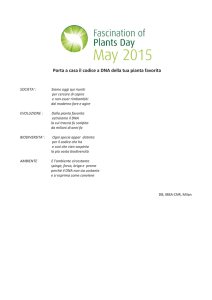
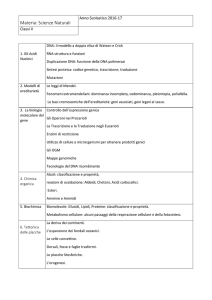
![(Microsoft PowerPoint - PCR.ppt [modalit\340 compatibilit\340])](http://s1.studylibit.com/store/data/001402582_1-53c8daabdc15032b8943ee23f0a14a13-300x300.png)
